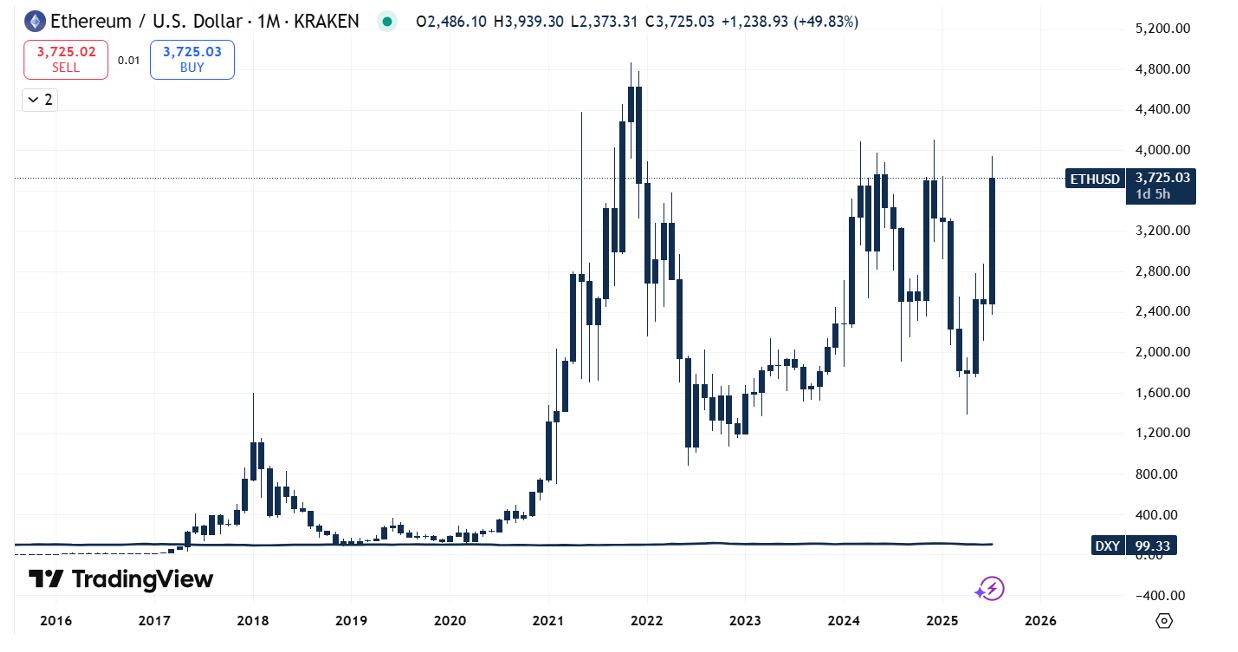Ethereum at 10: From Concept to Core Infrastructure

Ethereum launched a decade ago with the goal of transforming blockchain from a passive ledger into a programmable, decentralized platform. As of its 10-year anniversary, it holds a $450 billion market cap and plays a dominant role in global stablecoin settlement, establishing itself as the second-largest cryptocurrency by value and usage.1
What Is Ethereum and How Does It Work?
Ethereum is a decentralized blockchain network designed to support programmable smart contracts and decentralized applications (dApps). Unlike Bitcoin, which primarily serves as a digital store of value, Ethereum allows developers to build complex applications that run directly on its network, removing the need for centralized intermediaries.
At the heart of Ethereum is the Ethereum Virtual Machine (EVM), a global computing environment replicated across thousands of independent computers—called "nodes." These nodes work together to store data and verify transactions, ensuring that no single party controls the system. When users interact with Ethereum—whether transferring tokens, executing a loan on a decentralized finance (DeFi) platform, or minting an NFT, those instructions are executed by the EVM and recorded on the blockchain.
Following the 2022 "Merge" upgrade, Ethereum transitioned from a Proof-of-Work to a Proof-of-Stake (PoS) consensus mechanism. This shift drastically reduced energy consumption and changed how the network is secured. In PoS, validators lock up ETH as collateral and are selected at random to confirm transactions. They earn rewards for honest behavior and risk penalties (known as slashing) for malicious actions.
To improve scalability, Ethereum is advancing toward future upgrades such as sharding, a technique that splits the blockchain into smaller parts (shards) that can process transactions in parallel. In the meantime, Layer 2 solutions like rollups are already increasing throughput by batching thousands of transactions off-chain before settling them on Ethereum’s main network.
Together, these innovations are helping Ethereum evolve from an experimental platform into a foundational layer for global finance, digital identity, and on-chain commerce.2,3,4,5
Ethereum’s Progress
From its 2015 debut near $0.75 to prices exceeding $4,800 at peak, Ethereum’s price history reflects both exponential growth and cyclic volatility. After peaking near $4,800, prices corrected sharply, but have since rebounded nearly 3x, fueled in part by shifting regulatory signals and renewed institutional interest. Its market trajectory offers a visual record of its high economic relevance across the blockchain landscape. Recently, Ethereum has risen close to its former glory, nearly tripling over the past few months, with favourable government policies reshaping public perception over its development.

The Vision of Vitalik Buterin
Ethereum was conceived in 2013 by Vitalik Buterin, a Russian Canadian computer scientist and early contributor to the Bitcoin ecosystem. Buterin noticed key limitations in Bitcoin’s design, in particular, its simplicity, which lacked a transactional nature. He proposed a new blockchain architecture capable of supporting complex, self-executing applications; laying the groundwork for the modern smart contract ecosystem.6
How Ethereum evolved
Since its launch in 2015, Ethereum has evolved into the foundation of decentralized finance and on-chain innovation. Early developments such as the ERC-20 standard enabled tokenization at scale, driving a wave of application growth.7 As demand surged, Ethereum faced scaling limits, leading to the rise of Layer 2 networks.8 In 2022, it transitioned to Proof of Stake, reducing energy use by over 99% and setting the stage for further upgrades.9 With deflationary supply mechanics and a modular roadmap focused on scalability, Ethereum is positioning itself as the core settlement layer of a decentralized, global financial system.
The rise and fall of NFTs
Ethereum’s infrastructure was tested during the NFT boom, which drew mainstream attention and new users through tokenized art, media, and collectibles. While trading volumes and valuations have since declined, the NFT era highlighted Ethereum’s technical flexibility and pushed the boundaries of on-chain creativity. In hindsight, it clarified where sustainable demand exists and helped sharpen Ethereum’s broader application set.10
A New Era for Cryptocurrency – The Genius Act
On July 18, President Donald Trump signed the Genius Act into law. Among other provisions, it mandates that these stablecoins be tied to the U.S. dollar.11
This sets the stage for cryptocurrencies to go mainstream. The structure introduces institutional-grade safeguards, addressing longstanding concerns around transparency. By anchoring digital dollars to the stability of U.S. sovereign assets, the Act positions stablecoins as a credible and low-volatility mechanism for settlement, treasury operations, and cross-border transactions.
Although Ethereum is not a stablecoin itself, many tokens that directly use it are. With a growing number of Ethereum-based companies now anchored to the U.S. dollar, the network has acquired a heightened level of institutional credibility.12
Arcstone’s View
Ethereum’s first decade represents a landmark achievement in the evolution of digital finance. What began as a novel concept has matured into a foundational layer for global value transfer, decentralized infrastructure, and programmable asset issuance. Its ability to enable permissionless innovation while maintaining a high degree of security and resilience has established Ethereum as a cornerstone of the modern blockchain economy.
Looking ahead, Ethereum enters its second decade with growing institutional relevance and a clear trajectory toward long-term utility. Its infrastructure underpins a broad range of financial applications, cementing its role at the center of an increasingly digitized and programmable financial system. Ethereum is no longer an experiment; it is an essential infrastructure for the next era of global finance.




